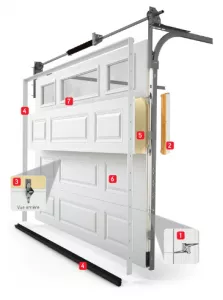Taken as a whole, most garage doors appear to be identical to all of the rest. This is particularly so when two doors have the same R-values (or RSI), and yet there may be a big difference. If you are the owner of the door, or considering its installation, you want to take a much closer look at things like effective thermal breaks and top-performing weatherseals. Why? If you are without them, you may be losing heat to the outdoors.
That means that you need to know what to do if shopping for a new door. Looking for the specific features below will help to reduce utility bills and keep your home or garage at a more comfortable level.

Look for Wooden End Blocks
Seeing the word wood when describing a modern and energy efficient door may seem unusual, but it all has to do with something known as thermal bridging. It is not unusual for North American garage door manufacturers to use a process of cutting steel sheeting about 26″ wide (66 cm) and also to the length needed for a door. To seal up the ends, they will use steel end caps, and this results in the metal allowing heat to transfer out of (or into) the garage, “bridging” the materials.
Quality door makers prefer section end blocks made of wood to keep the insulating material in place, hold the hinges to the ends of the door and serve as an optimal material for weatherstripping to be attached. Using that last method permits a glue joint that links the interior of the door to the metal sheets without any heat loss.
Naturally, Garaga has its own innovative approach. It uses a unique injection and manufacturing method that permits each section to be manufactured individually, and to cap them with wood end blocks before placing insulation. This eliminates the risks of a thermal break.
Joining Door Sections
The Garaga approach uses two exterior sheets of steel that cover the insulation, inside and out, as do many other makers. Their method attaches the two sides through the use of a metal staple with or without glue which can still cause the undesired transfer of heat.
Instead, Garaga relies on a thermal break made with a triple-contact PVC weatherseal to connect them. What does this do? It keeps exterior metal from contact with interior metal, eliminating a thermal bridge.
Importance of Weatherstripping Around the Exterior
Unlike many other garage door manufacturers who rely on a low quality PVC weatherstripping, which can fail if exposed to below freezing for just a few days, by hardening and losing flexion, Garaga prefers a top quality design. Theirs is a double-lipped, PVC weatherstripping flexible down to -15 ˚F (-25 °C).
Importance of Weatherstripping Along the Bottom of the Door
Just as weatherstripping around the door will often harden at freezing temps, so too does the seal along the bottom of the door and the threshold. Garage uses a TPE (Thermal Plastic Elastomer)-based weatherseal flexible down to -52 °F (-62 °C).
In Conclusion…
Your garage door’s energy efficiency is due to many factors, including components and construction. While many see the R-value or RSI as the key issue, it actually is not. Closely scrutinize the door and find out how it is made. There are many ways its construction can cause it to suffer energy loss, including the end sections, between sections and weatherstripping around and along the bottom.
Feel free to contact us toll-free anytime at 1-800-425-0662. Our knowledgeable advisors are always happy to explain the best choices for you based on your needs, and can also send out a free quotation by email. Come into our showroom or just go online and use our Design Centre to try out a few styles on your actual home, and use our image gallery for a lot of inspiration and innovation.

Add new comment